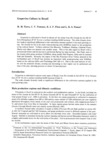Grapevine Culture in Brazil
JIRCAS international symposium series
| ISSN | 13406108 |
|---|---|
| 書誌レコードID(総合目録DB) | AA1100908X |

本文フルテキスト
intlsymp-3_45-48.pdf153.38 KB
Grapevine is cultivated in Brazil in almost all the states from Rio Grande do Sul (30° 53' S) to Pernambuco (9° 23' S) over a surface totalling 62,000 hectares. The wide climatic diversity leads to significant differences in the cultivation systems applied in the main growing areas. Rio Grande do Sul is the main wine-producing area (40,000ha), based on the production of the cultivar Isabel. Vinifera cultivars like Moscato, Trebbiano, Riesling, Cabernet Franc, Merlot and others are planted over smaller areas. This is the only region in Brazil with a pronounced winter and the harvest is performed during the rainy summer. Sao Paulo state is the largest table grape producer (10,000ha), using mainly Red Niagara, Italia and its mutants Rubi and Benitaka. Recently, the region of the Sao Francisco River Valley, situated in the northeastern part of Brazil has become an important table grape-growing area (3,000ha), based on the cultivars Italia and Piratininga (IAC 842-4 v). Due to the total absence of winter and the semiarid climate, pruning and harvesting in that region can be performed any time of the year, allowing growers to obtain 2.5 harvests/year.
| 作成者 | M. M. Terra C. V. Pommer E. J.P. Pires L. R. S. Passos |
|---|---|
| 公開者 | Japan International Research Center for Agricultural Sciences |
| オンライン掲載日 | |
| 号 | 3 |
| 開始ページ | 45 |
| 終了ページ | 48 |
| 言語 | eng |
